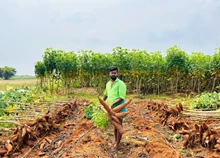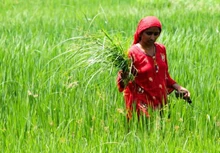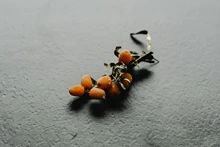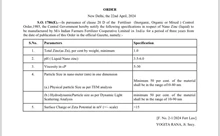
Coming from a family of generational farmers, Kailash Narayan Singh never trod the path of his forefathers. He, instead, was interested in businesses such as carpet-making, medicines, and water purifiers. As life would have it, Kailash moved away from all such businesses and ventured into fish farming at the ripe age of 58 in 2019. Now, he is using his marketing tactics to promote inland aquaculture and has trained hundreds of farmers in the same.
Fish farming has been very popular in the coastal parts of India. Kailash wanted to diversify this perspective and started an inland aquaculture business in the ancient city of Varanasi. The path was not easy, it still is not. To upskill himself, he attended numerous webinars regarding fish farming and learnt as much as he could about fish-rearing practices before starting the business.
Today, Kailash has trained more than a hundred farmers, among whom women are at the forefront. “Fish farming is very easy if done considering the scientific nuances of it,” he says. On average, it costs Rs 80-85 for fostering one kg of fish. Adding up all the costs, Kailash sells a kg of fish for Rs 100-105. It further goes for Rs 140 per kg as sold by the retailers. “There is always a brimming demand for fish in the market. We only must work towards fulfilling this demand with sufficient production,” he says. The prices are derived considering the quality, demand, and weight of the fish.
The Process Behind It
Kailash rears two kinds of fish: pangasius and catfish. Instead of waiting for one set of fish to grow in a year, he breeds them in three cycles with the help of a recirculation aquaculture system (RAS). When the fish are infants, they are kept in the RAS. Once they gain 250-300 grams, they are transferred into ponds.
The National Fisheries Development Board, Department of Fisheries Ministry of Fisheries, Animal Husbandry & Dairying, Government of India, defines RAS as a technology where water is recycled and reused after mechanical and biological filtration and removal of suspended matter and metabolites. This method is used for high-density culture of various species of fish, utilizing minimum land area and water.
So, Kailash had to establish an RAS with eight tanks of 25-by-25 feet, worth Rs 50 lakh, on which he got a 40% subsidy from the government. Initially, he was able to produce 200-300 quintals of fish, but in 2023 the production increased to 600-700 quintals and is only going to grow further. He shares that with the RAS model, marginal farmers can also rear fish on their small land. It is not necessary to wait for the fish to grow fully. One can also sell fish larvae in the market.
Overcoming the Odds
Kailash has incurred some losses every year. One major challenge has been to maintain a temperature of around 30 degrees Celsius which is appropriate for fish farming. In states such as Uttar Pradesh, the temperature falls sharply in winter, and fish farming often becomes a challenge.
Another set of hurdles include diseases and climate change. “To maintain fish’s health, water needs to be clean, and lack of awareness and availability of medicines are obstructing many people to sustain their fish farming business.” Speaking on climate change, he says, “It is inevitable.” Amid climate change, inland aquaculture is the solution for the fish industry to thrive, as marine animals are already in danger due to pollution.
Why Fish Farming Is Ready to Transition into an Industry
Kailash believes it is possible to build the fish farming industry pan-India, especially in the northern parts, only if these have better infrastructure to store fish and export them. Moreover, investment in research development is also needed. For instance, he says, “If the fishes catch some disease, a farmer must rush to a center in Lucknow. However, such facilities should be developed in every district for fish farming to prosper.”
Finally, many people who are inspired by aquaculture make mistakes by being greedy and damaging their business. To them, Kailash says, “If we begin with meticulous research and proper training, anybody can make huge profits out of aquaculture.”











